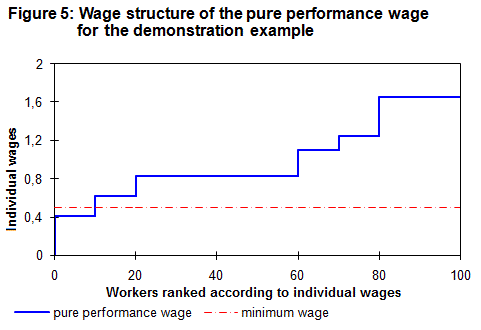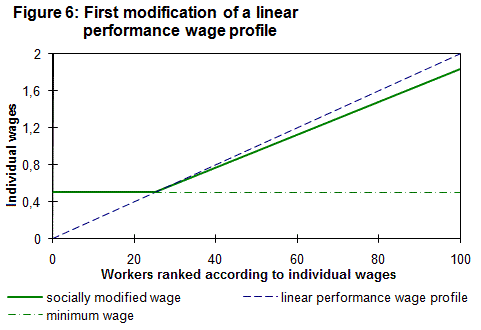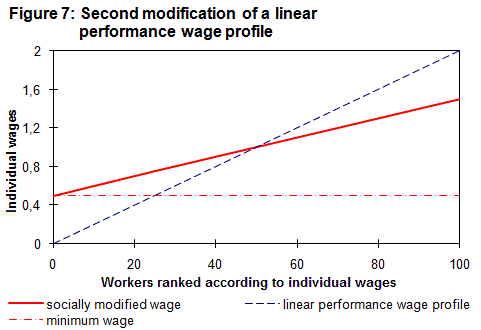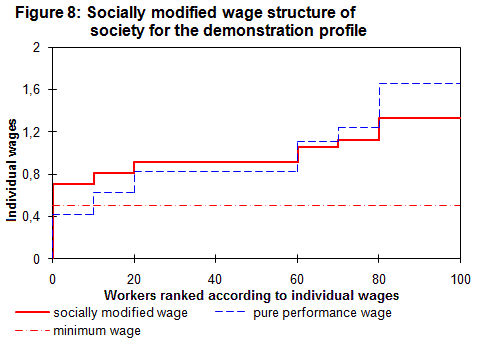7.3 Introduction of a social component into the remuneration system
So far, considerations have been only made as to how a labor market can be designed with a performance-oriented wage system so that every worker can be motivated to achieve a maximum performance within a profession and at the same time strive for a profession which leads to a needs-based performance structure with a maximum productivity for society as a whole. However, we have not yet given any thought to whether the result is also socially acceptable
Using our original demonstration example we can represent the wage or income profile for a society consisting of 100 workers by drawing a diagram in which for each worker this wage is plotted against the number of workers - ordered by the size of its individual wage. This creates the Figure of the wage structure in society. This is shown in Figure 5.

The area under this curve (solid line) represents the total societal wage volume. Let us assume that the necessary wage to buy the essential goods for survival is 0.5 (dash-dot line). In our demonstration example there is a performance group consisting of 10 workers who are not able to cover their essential needs for consumer goods with their performance wages.
In a social economic system, every member of society must be in a position to afford at least essential consumer goods. In a market economy wages are the main and usually the only source of income for most members of society. Accordingly, in a social market economy it must be ensured that every member of society who is capable of working can earn its necessary maintenance through individually realizable wages. This makes it necessary that for every work in full-time a corresponding minimum wage has to be paid.
Accordingly, the wage system modelled so far is not yet socially acceptable. So it has to be considered how this wage system can be modified without losing the performance orientation.

To simplify the illustration let's assume that the income profile is a straight line starting with the minimum wage equal to zero and ending with the maximum wage equal to two, and the necessary minimum wage is 0.5 (dash-dot line), according to Figure 6 (dashed line). This means that 25% of the workers cannot completely cover their vital needs.
The federal German social system works in the way that the members of society with income above the social welfare level raise the deficit through taxes. This money is redistributed to the people in need via the social welfare office. If one assumes, for the sake of simplicity, that the solidarity tax is proportional to the wage share that is above the social welfare level, the result is an income profile as shown in Figure 6 (solid line).This results in a corrected maximum income of 1.83.
The disadvantage of this solution is that 25% of the workers do not have any positive incentive to perform. This means that for all these workers it is ensured through social control and regulation (negative performance incentive = compulsion) that they bring their performance potential, albeit low, into the overall social work performance. (Provided that the society offers them a job, which is not to be discussed here.)

Instead, I would suggest modifying the incentive pay system as shown in Figure 7. There is positive motivation to perform right from the start. This system would be easier to implement from an administrative point of view. In our example, the peak income continues to decrease from 1.83 to 1.5. But I don't see a problem in this since for top earners the largest part of the income keeps being performance-related (in our example it is still 2/3). Problems could only arise in the lower income groups.

The application of this suggestion for a social modification of the performance wage system to our demonstration example is shown in Figure 8 (solid line). In addition, the income profile of the plain performance wage was entered as a dashed line and the necessary minimum wage as a dash-dotted line.
These considerations show that a performance wage system in a social market economy, and thus the market economy as a whole, can only function if a surplus product for society as a whole is generated which allows additional consumption to what is existentially necessary. The more favourable the relationship between additional and necessary consumption, the more effective the performance principle is likely to be. A prerequisite is, however, that the social surplus product is distributed via a relating performance wage system and is not withdrawn from the cycle of consumption through private capitalist appropriation.
Return Go on